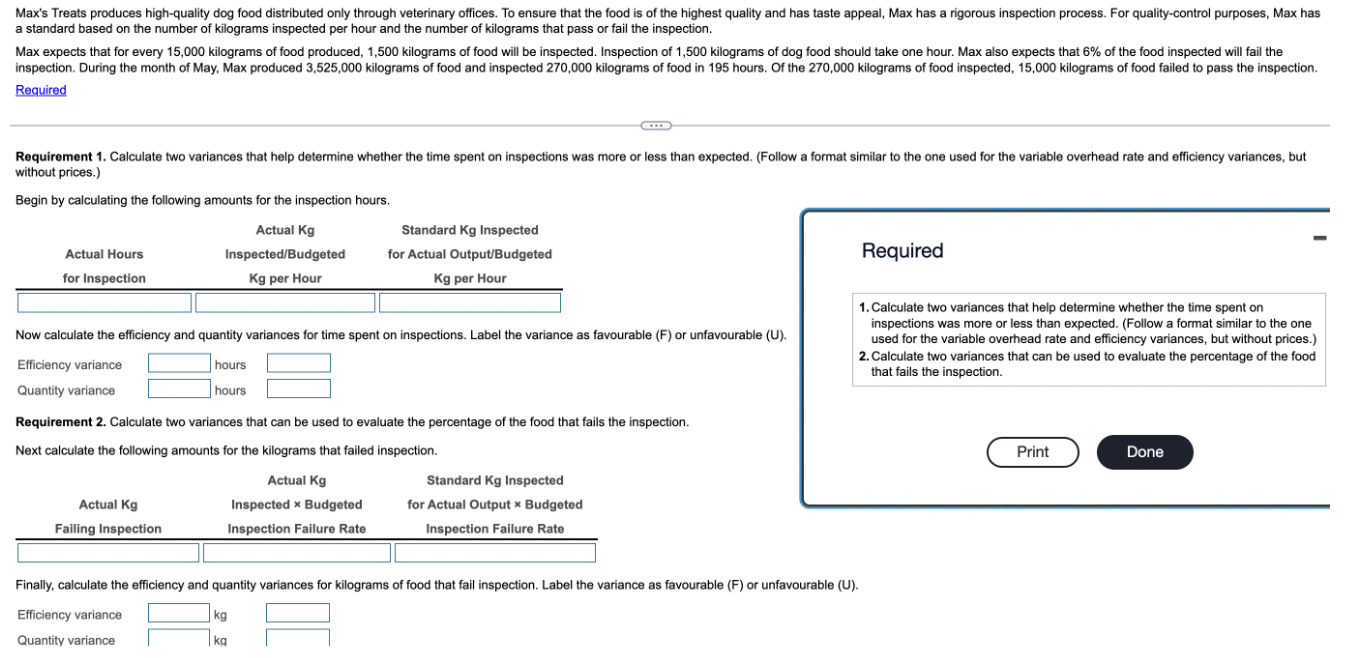Answered step by step
Verified Expert Solution
Question
1 Approved Answer
Max's Treats produces high-quality dog food distributed only through veterinary offices. To ensure that the food is of the highest quality and has taste

Max's Treats produces high-quality dog food distributed only through veterinary offices. To ensure that the food is of the highest quality and has taste appeal, Max has a rigorous inspection process. For quality-control purposes, Max has a standard based on the number of kilograms inspected per hour and the number of kilograms that pass or fail the inspection. Max expects that for every 15,000 kilograms of food produced, 1,500 kilograms of food will be inspected. Inspection of 1,500 kilograms of dog food should take one hour. Max also expects that 6% of the food inspected will fail the inspection. During the month of May, Max produced 3,525,000 kilograms of food and inspected 270,000 kilograms of food in 195 hours. Of the 270,000 kilograms of food inspected, 15,000 kilograms of food failed to pass the inspection. Required Requirement 1. Calculate two variances that help determine whether the time spent on inspections was more or less than expected. (Follow a format similar to the one used for the variable overhead rate and efficiency variances, but without prices.) Begin by calculating the following amounts for the inspection hours. Actual Hours for Inspection Actual Kg Inspected/Budgeted Standard Kg Inspected Kg per Hour for Actual Output/Budgeted Kg per Hour Required Now calculate the efficiency and quantity variances for time spent on inspections. Label the variance as favourable (F) or unfavourable (U). Efficiency variance Quantity variance hours hours Requirement 2. Calculate two variances that can be used to evaluate the percentage of the food that fails the inspection. Next calculate the following amounts for the kilograms that failed inspection. Actual Kg Failing Inspection Actual Kg Inspected x Budgeted Inspection Failure Rate Standard Kg Inspected for Actual Output * Budgeted Inspection Failure Rate 1. Calculate two variances that help determine whether the time spent on inspections was more or less than expected. (Follow a format similar to the one used for the variable overhead rate and efficiency variances, but without prices.) 2. Calculate two variances that can be used to evaluate the percentage of the food that fails the inspection. Print Done Finally, calculate the efficiency and quantity variances for kilograms of food that fail inspection. Label the variance as favourable (F) or unfavourable (U). Efficiency variance Quantity variance kg kg
Step by Step Solution
There are 3 Steps involved in it
Step: 1
Requirement 1 Efficiency Variance Hours Actual Hours Inspected 195 hours Budgeted Hours for Actual O...
Get Instant Access to Expert-Tailored Solutions
See step-by-step solutions with expert insights and AI powered tools for academic success
Step: 2

Step: 3

Ace Your Homework with AI
Get the answers you need in no time with our AI-driven, step-by-step assistance
Get Started


